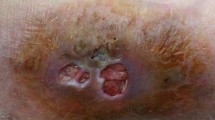Abstract
Phaeohyphomycosis is a term used to describe a heterogenous group of cutaneous and systemic mycotic infections caused by melanized fungi. Many fungi have been reported as pathogens of this disease. The disease spectrum ranges from superficial cutaneous infections, deep cutaneous infections, to systemic infections with internal organ involvement. We report two cases of deep cutaneous phaeohyphomycosis on the foot clinically presenting as cellulitis with abscess formation. The pathogens were isolated from the lesion and both were identified as Neoscytalidium dimidiatum by their colony morphology, microscopic features, and sequences of internal transcribed spacers of ribosomal DNA. Both patients did not respond to the therapy with voriconazole and itraconazole, but improved after intravenous amphotericin B.



Similar content being viewed by others
References
Mohd MH, Salleh B, Zakaria L. Identification and molecular characterizations of Neoscytalidium dimidiatum causing stem canker of red-fleshed dragon fruit (Hylocereus polyrhizus) in Malaysia. J Phytopathol. 2013;161(11–12):841–9.
Machouart M, Menir P, Helenon R, Quist D, Desbois N. Scytalidium and scytalidiosis: What’s new in 2012? J Mycol Med. 2013;23(1):40–6.
Oyeka C, Gugnani H. Keratin degradation by Scytalidium species and Fusarium solani. Mycoses. 1998;41(1–2):73–6.
Verrier J, Monod M. Diagnosis of dermatophytosis using molecular biology. Mycopathologia. 2017;182(1–2):193–202.
Crous PW, Slippers B, Wingfield MJ, Rheeder J, Marasas WF, Philips AJ, et al. Phylogenetic lineages in the Botryosphaeriaceae. Stud Mycol. 2006;55:235–53.
Madrid H, Ruíz-Cendoya M, Cano J, Stchigel A, Orofino R, Guarro J. Genotyping and in vitro antifungal susceptibility of Neoscytalidium dimidiatum isolates from different origins. Int J Antimicrob Agents. 2009;34(4):351–4.
Zaatari GS, Reed R, Morewessel R. Subcutaneous hyphomycosis caused by Scytalidium hyalinum. Am J Clin Pathol. 1984;82(2):252–6.
Benne C, Neeleman C, Bruin M, De Hoog G, Fleer A. Disseminating infection with Scytalidium dimidiatum in a granulocytopenic child. Eur J Clin Microbiol Infect Dis. 1993;12(2):118–21.
Levi ME, Smith JW. Posttraumatic infection due to Scytalidium dimidiatum. Clin Infect Dis. 1994;18(1):127–8.
Rockett MS, Gentile SC, Zygmunt KH, Gudas CJ. Subcutaneous phaeohypomycosis caused by Scytalidium dimidiatum in the foot of an immunosuppressed host. J Foot Ankle Surg. 1996;35(4):350–4.
Marriott D, Wong K, Aznar E, Harkness JL, Cooper DA, Muir D. Scytalidium dimidiatum and Lecythophora hoffmannii: unusual causes of fungal infections in a patient with AIDS. J Clin Microbiol. 1997;35(11):2949–52.
Sigler L, Summerbell RC, Poole L, Wieden M, Sutton DA, Rinaldi MG, et al. Invasive Nattrassia mangiferae infections: case report, literature review, and therapeutic and taxonomic appraisal. J Clin Microbiol. 1997;35(2):433–40.
Dhindsa M, Naidu J, Singh S. A case of subcutaneous infection in a patient with discoid lupus erythematosus caused by a Scytalidium synanamorph of Nattrassia mangiferae, and its treatment. Med Mycol. 1998;36(6):425–7.
Aamir S, Aman S, Haroon T. Mycetoma caused by Scytalidium dimidiatum. Br J Dermatol. 2003;148(1):174–6.
Morris-Jones R, Youngchim S, Hextall J, Gomez B, Morris-Jones S, Hay R, et al. Scytalidium dimidiatum causing recalcitrant subcutaneous lesions produces melanin. J Clin Microbiol. 2004;42(8):3789–94.
Willinger B, Kopetzky G, Harm F, Apfalter P, Makristathis A, Berer A, et al. Disseminated infection with Nattrassia mangiferae in an immunosuppressed patient. J Clin Microbiol. 2004;42(1):478–80.
Sriaroon C, Vincent AL, Silapunt S, Chandler A, Houston SH, Greene JN. Successful treatment of subcutaneous Scytalidium hyalinum infection with voriconazole and topical terbinafine in a cardiac transplant patient. Transplantation. 2008;85(5):780–2.
Padhi S, Uppin SG, Uppin MS, Umabala P, Challa S, Laxmi V, et al. Mycetoma in South India: retrospective analysis of 13 cases and description of two cases caused by unusual pathogens: Neoscytalidium dimidiatum and Aspergillus flavus. Int J Dermatol. 2010;49(11):1289–96.
Moutran R, Maatouk I, Wehbé J, Abadjian G, Obeid G. Subcutaneous infection spread by Scytalidium (Neoscytalidium) dimidiatum. Ann Dermatol Venereol. 2012;139(3):204–8.
Garinet S, Tourret J, Barete S, Arzouk N, Meyer I, Frances C, et al. Invasive cutaneous Neoscytalidium infections in renal transplant recipients: a series of five cases. BMC Infect Dis. 2015;15(1):535.
Lanternier F, Barbati E, Meinzer U, Liu L, Pedergnana V, Migaud M, et al. Inherited CARD9 deficiency in 2 unrelated patients with invasive Exophiala infection. J Infect Dis. 2015;211(8):1241–50.
Drummond RA, Franco LM, Lionakis MS. Human CARD9: a critical molecule of fungal immune surveillance. Front Immunol. 2018;9:1836.
Chuang M, Ni H, Yang H, Shu S, Lai S, Jiang Y. First report of stem canker disease of Pitaya (Hylocereus undatus and H. polyrhizus) Caused by Neoscytalidium dimidiatum in Taiwan. Plant Dis. 2012;96(6):906.
Lai SY-H. Superficial scute infection caused by Scytalidium sp. in the carapace of Aldabra Giant Tortoises (Geochelone gigantea). Taipei Zoo Bull. 2012;23:91–6.
James JE, Santhanam J, Lee MC, Wong CX, Sabaratnam P, Yusoff H, et al. In vitro antifungal susceptibility of Neoscytalidium dimidiatum clinical isolates from Malaysia. Mycopathologia. 2017;182(3–4):305–13.
Elinav H, Izhar U, Benenson S, Admon D, Hidalgo-Grass C, Polacheck I, et al. Invasive Scytalidium dimidiatum infection in an immunocompetent adult. J Clin Microbiol. 2009;47(4):1259–63.
Khan Z, Ahmad S, Joseph L, Chandy R. Cutaneous phaeohyphomycosis due to Neoscytalidium dimidiatum: first case report from Kuwait. J Mycol Med. 2009;19(2):138–42.
Lacroix C, de Chauvin MF. In vitro activity of amphotericin B, itraconazole, voriconazole, posaconazole, caspofungin and terbinafine against Scytalidium dimidiatum and Scytalidium hyalinum clinical isolates. J Antimicrob Chemother. 2008;61(4):835–7.
Author information
Authors and Affiliations
Corresponding author
Ethics declarations
Conflict of interest
The authors declare that they have no conflict of interest.
Additional information
Handling Editor: Vishnu Chaturvedi.
Rights and permissions
About this article
Cite this article
Yang, SJ., Ng, CY., Wu, TS. et al. Deep Cutaneous Neoscytalidium dimidiatum Infection: Successful Outcome with Amphotericin B Therapy. Mycopathologia 184, 169–176 (2019). https://doi.org/10.1007/s11046-018-0308-z
Received:
Accepted:
Published:
Issue Date:
DOI: https://doi.org/10.1007/s11046-018-0308-z




